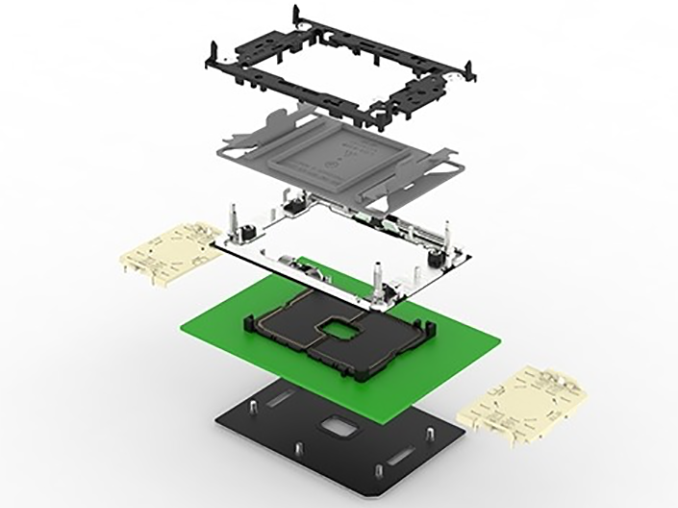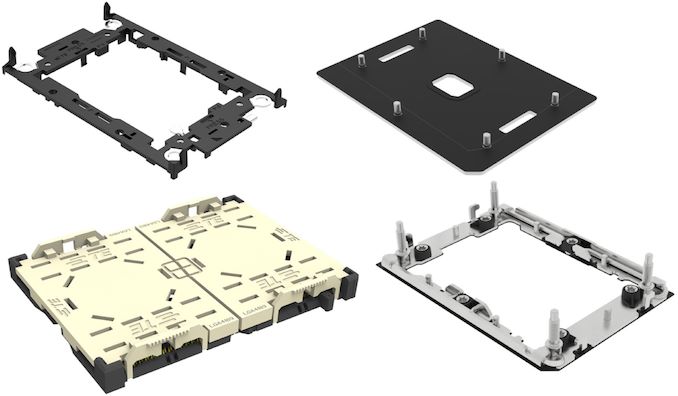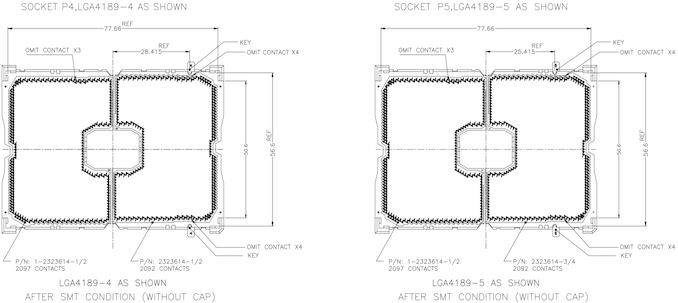Intel’s LGA4189-4 and LGA4189-5 for Cooper Lake & Ice Lake CPUs Now Available
by Anton Shilov on September 2, 2019 10:35 AM EST- Posted in
- CPUs
- Intel
- Ice Lake
- Xeon Scalable
- LGA4189
- Cooper Lake

TE Connectivity, a maker of various connectivity solutions, has introduced its newly-developed LGA4189 sockets for Intel’s next-generation Xeon Scalable processors supporting PCIe Gen 4. The products have been validated by Intel and are therefore ready for production of motherboards aimed at next-gen servers. It is worth noting that we already know some Cooper Lake systems are already deployed at large companies, suggesting that some LGA4189 sockets have been validated already.
TE offers LGA4189-4 and LGA3189-5 sockets (which are called Socket P4 and Socket P5), appropriate backplates, compatible bolster plates, mounting mechanisms, and dust covers. As discovered previously, Intel’s next-generation Xeon Scalable processors in LGA4189 packaging will feature a native eight-channel memory controller and PCIe 4.0, with at least eight channel memory on standard configurations.
One interesting thing to note is that TE Connectivity will offer Intel’s LGA 4189 socket in two versions: the LGA4189-4 (branded as Socket P4) and the LGA4189-5 (branded as Socket P5). Being a socket maker, TE indicates that key features of Socket P4 and Socket P5 are the same: they have the same pin count, the same 0.9906 mm hex pitch, the same SP height of 2.7 mm, and the same mounting mechanisms. Meanwhile, the company does not disclose why Intel needed two separate 4189-pin sockets. Keeping in mind that Intel will have two next-generation Xeon Scalable processors — codenamed Cooper Lake and Ice Lake — it looks like that the the single-die CPUs and multi-die CPUs will use different sockets and will not be pin-to-pin compatible despite the fact that they are going to use the same platform.
A 4189-pin socket that has to provide sufficient 56-core power and support ultra-fast interconnections is extremely complex to build. TE is currently “one of the few manufacturers that can provide sockets and hardware” for Intel’s next-gen server CPUs, the company said. Meanwhile, TE says that its LGA4189 hardware is now available to interested parties, such as server makers.
Related Reading
- Power Stamp Alliance Exposes Ice Lake Xeon Details: LGA4189 and 8-Channel Memory
- Intel Xeon Update: Ice Lake and Cooper Lake Sampling, Faster Future Updates
- Intel to Offer Socketed 56-core Cooper Lake Xeon Scalable in new Socket Compatible with Ice Lake
- Intel Architecture Manual Updates: bfloat16 for Cooper Lake Xeon Scalable Only?
- Cisco Documents Shed Light on Cascade Lake, Cooper Lake, and Ice Lake for Servers
Source: TE Connectivity












31 Comments
View All Comments
Chaitanya - Monday, September 2, 2019 - link
In last paragraph, word sufficient is out of place.PeachNCream - Tuesday, September 3, 2019 - link
Also.."Being a socket maker, TE indicates that key features of Socket P4 and Socket P5 are the same: they have the same pin count, the same 0.9906 mm hex pitch, the same SP height of 2.7 mm, and the same mounting mechanisms."
Leading in with the words "being a socket maker" is unnecessary and doesn't add anything but word count to an already lengthy sentence.
Gondalf - Monday, September 2, 2019 - link
Likely one socket is for Cooper Lake and the other for Ice Lake. Both SKUs will are mutidie but Cooper reporderly will be three dies (two compute, one I/O) Ice Lake could be four dies (three compute, one I/O) AKA 26x3=78 cores instead of 56. The Ice Lake large die is 26 cores so the 3x configuration is almost sure because only 52 cores could be useless against Epyc in some workloads.Another secret are the thermals but a 300W Cooper is likely dropping the base speed and the all core turbo speed versus actual AP line. About Ice Lake there is a old slide saying 230W but all depend on how many 300mm2 10nm dies Intel will put together.
Ian Cutress - Monday, September 2, 2019 - link
Intel has already stated that Cooper and Ice will share a socket and be upgradeable.Arsenica - Monday, September 2, 2019 - link
Considering that Ice and Copper lake are advertised as part of the same platform (Whitley), the LGA4189-5 variant could be intended for the DDR5/PCIe5 successor (Sapphire/Granite Rapids)Santoval - Monday, September 2, 2019 - link
If that was the case the socket would not be apparently identical. Intel are not going to switch to DDR5 before their Tiger Lake Xeon series (to be released in the holiday season of 2020 or in Q1 2021), which is the next Xeon platform after Whitley. Apparently that would also be the platform to introduce PCIe 5.0, since as we know PCIe 4.0 is going to be very short lived.*If*, and that's still a big "if" they manage to produce Tiger Lake desktop CPUs at an acceptable yield and clock frequency and launch them some time in Q3 or Q4 of 2020 (their Ice Lake desktop CPUs were canned) they might switch them to DDR5 first. As things stand now, that might not happen : Ice Lake desktop was replaced by Comet Lake and Tiger Lake desktop will probably be replaced by Rocket Lake.
More likely in mid-late 2020 to early 2021 we will have a repeat of the same : 4-core (no more) Tiger Lake-U/Y parts and later in 2021 Tiger Lake Xeons, with no 10nm fabbed desktop CPUs. Unless Intel fix their shit, that is.
III-V - Tuesday, September 3, 2019 - link
>If that was the case the socket would not be apparently identical.Why not? These things tend to have a fair number of reserved/unused pins. They don't need to physically change the socket, other than re-keying it to prevent customer support nightmares.
Kevin G - Tuesday, September 3, 2019 - link
Example: see the three different variant of LGA 2011 which each had different memory technologies.DanNeely - Tuesday, September 3, 2019 - link
Unlike the consumer world where Intel has learned its lesson with LGA775 a decade+ ago and the ongoing repeat of that compatibility mess that AMD is doing with their current mainstream sockets; Intel is willing to reuse sockets for mutually incompatible systems in the workstationish/server markets. LGA2011 went through three such revisions before being replaced with LGA2066.Arsenica - Tuesday, September 3, 2019 - link
They are not identical. LGA4189-4 has a key 28mm away from the center of the package while LGA-4189-5 has it 25mm away from the center.